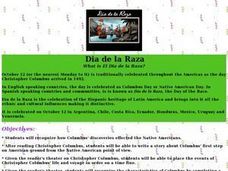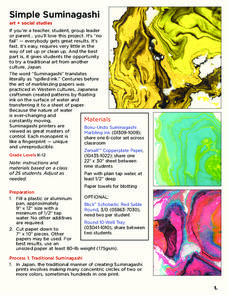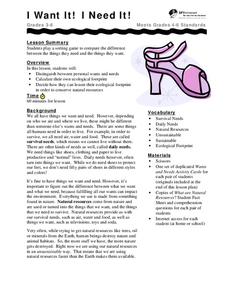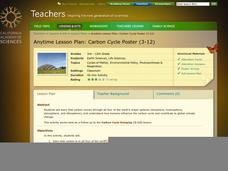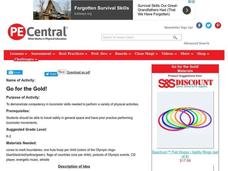Curated OER
Self Acceptance
Students explore their own self concept. They draw a picture of themselves, read a story, and write a story that has a character like themselves. Afterward, they write and illustrate their stories in PowerPoint.
Curated OER
Fall vs. Spring
Students compare fall and spring. In this seasonal changes lesson, students read the book Apples and Pumpkins and discuss the fall season. The students then read It's Spring and describe the spring season. As a culminating activity,...
Curated OER
Dia de la Raza - What is El Dia de la Raza?
Students research and write about Christopher Columbus, his voyages, and his impact on the Native Americans. In this Christopher Columbus lesson, students work at stations where they learn vocabulary, perform Reader's Theatre, work with...
Curated OER
Snap! Crackle! Box!
High schoolers develop a new cereal and design a box for it. In this art and design lesson, students complete a year-end cumulative activity in which the use all of their artistic skills to develop a new cereal. They use their marketing...
Curated OER
Sustainable Livestock
Students investigate healthy eating habits by researching livestock. In this food sustainability lesson, students research the negative impact factory farming has on our environment due to pollution. Students define agricultural...
Curated OER
Simple Suminagashi
What a wonderful way to meld art and culture! Learners create art work in the Suminagashi style using this detailed lesson plan. This art form, which is Japanese in origin, employs ink to create beautiful results. This will be a hit with...
Dick Blick Art Materials
Simple Suminagashi
Go ahead. Spill the ink! Combine the study of art, social studies, and science with a Suminagashi (spilled ink) activity that produces "unique and unreproducible" works of art.
Dick Blick Art Materials
Painted Story Quilt
Creating story quilts is a great way to combine art, social studies and literature. Kids select a story, a published one or one of their own, to illustrate, paint on a canvas square, embellish, and mount on a felt backing.
City and County of San Francisco
I Want It! I Need It!
Discuss wants and needs with your elementary ecologists and get them to consider what would happen to our natural resources if we all got everything that we want. Learners play a card sorting game and take an ecological footprint quiz on...
California Academy of Science
Carbon Cycle Poster
Humans can have a big impact on the environment, specifically the influence they have on the carbon cycle. First, the class will define and discuss each of the earths four major spheres, the biosphere, hydrosphere, atmosphere, and...
Curated OER
Crowley's Ridge: An Upland in the Lowlands
Young geographers examine how Crowley's Ridge was formed. This is one Arkansa's six natural geologic divisions. The history of Crowley's Ridge is important in that the first settlers of the state were attracted to this region, and it...
Curated OER
Hot, Hot, Hot, Cold
Learners dance the image of falling snow. They move, swing, fall, and rise to music working to depict snow falling, the sun, and high/low movements. This is a well-thought out instructional activity that aids them in seeing movement as a...
Perkins School for the Blind
Integrated Skills - Laundry
I hate doing laundry, even if it is an independent living skill that requires me to count money, follow a sequence, and sort clothing by color. Learners with multiple disabilities discuss what laundry is, why they need to do it, and how...
Texas State Energy Conservation Office
Investigation: Chemical Models
Science teams make models of four different hydrocarbon compounds that we commonly use for fuel. Then they demonstrate chemical reactions that result when energy is produced. This can be used as an enrichment when your class is studying...
Captain Planet Foundation
Solar Cooking Race
Study heat transfer with activities that focus on how heat energy works. Using a solar cooker, ice cubes, and heat transfer bracelets, kids experiment and record what they find by keeping ice cubes cold and vegetables hot.
Curated OER
Fall Reflections Monoprints
Create a natural autumn scene using the monoprinting method. Class members work on creating an image with reflection, foreground, and background using one line.
California Academy of Science
Pollution in Our Watershed
The concept of a how pesticides and other chemicals pass through a watershed can be difficult for younger learners to grasp without a concrete example. In the activity here, some blank paper, markers, and a spray bottle are all you need...
Sargent Art
Picasso and Beyond!
After reviewing the life and art of Pablo Picasso, learners set out to create abstract, cubist, relief portraits. They'll draw, color, paint, and cut out portraits just like the ones Picasso created. The lesson is extremely well written...
Science Matters
Energy and Winds
In the study of wind energy, scholars build a small windmill and observe how it transfers wind into mechanical energy. Learners will make connections to the previous lesson plan with concepts such as the creation of wind...
Curated OER
Fast Fact-Finding
Ever wonder why the sky changes color so often? Readers examine an informational excerpt from John Farndon's How the Earth Works. They underline key points as they read and then answer five response questions. Prompts review main...
Curated OER
Observation Milk Fat Lesson
Turn your class loose to experiment with the different fat content in skim milk, whole milk, half and half, and heavy cream. This is a visually vibrant experiment, as learners drip food coloring on the surface of the products and measure...
Curated OER
Go for the Gold!
Young athletes practice various locomotor movements. They use locomotor skills as directed by the teacher to move between "Olympic rings" (hula hoops). Students participate in a discussion about Olympic events prior to playing the game.
Cornell University
Spectral Analysis with DVDs and CDs
Build a spectrometer to analyze properties of light. Scholars examine the spectrum from CDs and DVDs from two different light sources. Using the spectrum, they work to identify different elements.
Curated OER
Easy Tie Die
Perfect for summer camp, an after school program, or your classroom, these instructions will make tie-dying a breeze! Simple instructions and helpful images make tie dying a fun and easy project. Tip: Have learners predict the outcome of...




